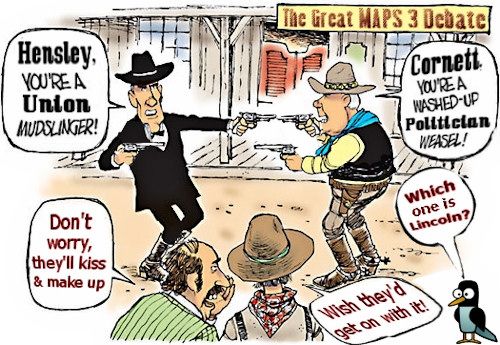
Mayor Mick Cornett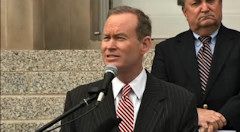 | FOP Pres. Gil Hensley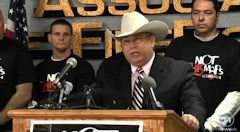 |
Press Conferences The City's Offer My Commentary
Where's the Class? Parsing the Words
City Press Conference Union Press Conference
Document Appendix
Sipe Memo 1989 Ballot 1992-93 Litigation Administration Paid
Firefighters Personnel 1998 Agreement FOP Letter
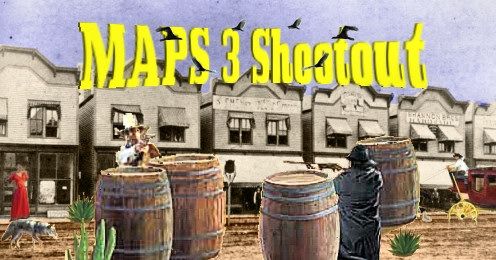
The November 12 press conference lasts about 9 minutes (but does not contain any Q & A since the NewsOK.com video didn't) and the November 13 about 11½ minutes. If you want to see the video files from which I ripped the audio, they are presently available at NewsOK.com: November 12 video and November 13 video.
| Mayor Cornett opened the November 12 press conference by saying that, in the last few years, "a strong economy has allowed us to support a high level of commitment to public safety." He reviewed the time since 1993 with the passage of MAPS, saying that the economy has benefited and that, "there is no question that public safety commitment has grown on an ever increasing basis." He noted that with the 2001 MAPS for Kids, the city council also passed a resolution that the accompanying use tax would be used for public safety. "MAPS has directly benefited public safety through the years." "Right now at a critical time in our city's history we're facing union efforts that I think are designed to confuse our voters into thinking that, somehow, that if MAPS passes, it creates public safety issues. And I can assure you that if MAPS does not pass our public safety issues multiply." "We have discussed ideas of how the accompanying MAPS use fee could be used not only used to support existing capital needs for public safety but also to actually increase the number of firefighters and police officers that we put on the street." He closed his remarks by saying, "We will not have that option if MAPS 3 does not pass." David Prater, former police officer and present District Attorney, was next. About the business community and city leadership, he said that he thinks, "they do believe in and support fire fighters and police officers." About a city offer to the police and firefighters unions, he commended mayor, city council, chamber, for "coming to some kind of a fiscally responsible resolution to this manpower issue — to start really looking responsibly at how we address the manpower shortage in Oklahoma City — and I believe their proposal through the MAPS 3 use tax has done exactly that. It will assure us that through rest of this fiscal year and next fiscal year we will see no cuts of police officers, period. No matter what we experience in our sales tax revenue shortfalls. In addition to that, they have proposed to add an additional 20 officers through MAPS use tax and an additional 7 officers through Cop grants. So we're looking at a swing, a possible swing, of 50 officers over the next couple of years. In addition to that, this city and their leadership has pledged that over the next 24 months they will sit down with our men and women in the firefighters union, our men and women in the police union, and work toward a long term effective solution to our manpower issue. And so I am hopeful that our men and women who are firefighters, our men and women who are our outstanding police officers in this city will take a good hard look at this proposal, this responsible proposal, that's been made by the City of Oklahoma City, and let's move forward and continue to grow this city in an effective and a responsible way." Gary Marrs, former Fire Chief and present Ward 1 council member, began by saying that, "When it comes to support for our public safety units, the frustration I have is that the message is being sent out there that the council doesn't support public safety, or hasn't supported it, or that MAPS specifically hasn't supported it. And that's just not true. If you look at our current budget this year, current general fund budget, 285 million dollars of that goes toward public safety, that's 2/3 of our general fund budget. And, you know, I, I don't know how you can say we don't support public safety when you make that kind of commitment on a yearly basis." "Specifically, how does MAPS support it? The MAPS for kids use tax has provided over 60 million dollars for public safety. So, the importance of the MAPS program can't be overstated, I don't think. And, you couple that with the mayor's comment on how the economic development, the economy in Oklahoma City, is as strong as it is, we think, because of the MAPS program, and because of that economy we haven't had the layoffs and we haven't had to furlough people. And you don't have to go very far outside of Oklahoma city to find that that's not true elsewhere. So, I think the issue of do we support public safety as a city and as a council, we can stand on the fact of what we've put into it so far. It's just a critical time right now. If we do believe that the previous MAPS has created a city where the economy will continue to support the priorities that we place out, it's a critical time to continue the growth of that. And the MAPS initiative that you're going to vote on December 8 will do just that. When you look at the kind of projects and the kind of growth that you're going to get in the city and how that can continue to grow our economy so we can continue the priority that the council has placed on it, and will continue to place on it. If we don't pass MAPS and we don't get to gain the strength that that will bring to our economy, then I don't think that's going to be a good thing or be something we want to forecast at this point in time." "I just think it's critical to understand how important it is for public safety instead of being a detriment to public safety." Mayor Cornett closed the press conference by saying, "Also, I want to remind everyone in this city of one of the key elements that has allowed our city to progress in the manner that it has, and to elevate ourselves and be very competitive in a national environment, and that's the unity that this city has obtained and earned through the years. We have so many people, the business community, the voters, the leadership at city hall, all pulling on the same rope. And now's the time for us to come together and do it one more time in the most important election of our time, MAPS 3." Questions were then taken but unfortunately they are not included in the video from which the sound file here was ripped, and I therefore have no report on that. | Phil Sipe, president of the Firefighters Union, opened the November 13 press conference: "Let me begin by saying that we are deeply disappointed but not surprised by the comments made by Mayor Cornett and others at yesterday's news conference. The December 8 election is about the citizens of Oklahoma City deciding whether or not they want to approve a package of projects that are totaling 3/4 of a billion dollars and it's not about negotiated issues between police and fire and the City of Oklahoma City. As public servants we want to make it very clear that we love this city very much and have dedicated our lives to protecting the citizens of this city. We have established enormous public trust by providing excellent public safety services and programs. For these reasons we feel that MAPS 3 is a bad plan. We feel like that for weeks the mayor has touted a list of projects in the MAPS 3 initiative which would include a downtown convention center, a new 70 acre central park, a new rail-based street car system and improvements to the Oklahoma State Fairgrounds. Yet never once has the mayor talked about public safety needs as a part of that list. Not one time have you seen mention of public safety on their website or in any of the printed brochures or audio-visual presentations from the Yes Maps coalition. Not until yesterday. And I believe we all know why. The mayor and others have come to realize that the public, by and large, does not support this MAPS. This MAPS proposal costs too much money for too many unneeded projects at a time when too many people are concerned about their own jobs, not a pie in the sky promise of new jobs that might be created if MAPS 3 passes, if MAPS 3 passes. Furthermore I believe the public is both aware and concerned that they have adequate fire and police protection before they have another nice park or even sidewalks or riding trails." Gil Hensley, president of the Fraternal Order of Police, then said: "This coalition wants to be perfectly clear about our intentions and goals. Police and fire are united in this efforts to defeat this MAPS proposal because it costs too much — 777 million dollars for too long — 7 years — with no written guarantees that named projects will ever be funded or in what order. The citizens of Oklahoma City work too hard, love their community too much, to give a blank check to a bunch of politicians in these uncertain economic times. Firefighters and police officers are joining ranks with citizens from all parts of the city and all walks of life in this campaign. We will knock doors, we will put up signs, make calls, and do everything possible to get our message out about why this is not a good proposal and should be rejected by the voters on December 8." Phil Sipe then added, "I would just like to further add that we believe the comments yesterday from the mayor about the use of use tax money for public safety funding I think confuses the public. We believe that whenever you make a very public statement like that, it falls in line with what we've said all along about the MAPS 3 initiative and about it not being specific enough for the voters to understand or to have an assurance that those projects will be completed as has been touted all along. The use tax funding proposal gave no specifics as to how much of the use tax dollars would be used for public safety or now long the use tax would be committed to public safety or how those dollars would be allocated to public safety. Again, no specifics, no plan, no direction, and this is what we feel like the MAPS initiative as it currently stands is all about." Brian Walters, Ward 5 Council Member, then took the podium. He said, "As has been said, it's not about defeating MAPS, it's about this particular package. It's way too much money at this particular time for projects that there's very little accountability for. We want the city to do better than this. I think the city can do better than this. I think we can put a better package out there for the voters to give them the same satisfaction that they would receive from this but at a lot less cost. It is my hope that if this goes down in December that we can come back with something later on that addresses the needs of Oklahoma City and not just a bunch of wants. So, I appreciate the opportunity to stand up here with these guys who serve the citizens like I do every day and say that this is a project that we can do better with and we expect to do better with and the citizens deserve better than what this is." After making comments about how people could become involved in the campaign, Phil Sipe opened the floor for questions. An inaudible question was asked which evidently related to items in the city's proposal that might be favored, individually. Brian Walters said: "There's 3/4 of a billion dollars in this proposal. $175 million of that is stuff that people want. There's $600 million of that people don't want. So they're spending a lot of money on things that are not wanted. And the only reason that they're doing that is because is because that's the only way you'd get the support of the Chamber. So basically they're spending $600 million dollars to convince themselves to vote for it." Following up, he said, "The sidewalks polled very high. The trails polled very high. But a number of the other projects, specifically the convention center, polled very very low, I think it was in the low 30%. And that is the most expensive project on there. And it also doesn't complete the convention center. That's only the first portion of that, it's not the complete thing. So at some point down the future, the citizens would have to foot a bill of another, say, quarter of a billion dollars, to finish it out." |
Gil Hensley added, "They did make a proposal, John, and we looked at it very seriously. Here's the problem. We're police officers and we're fire fighters because we want to serve the citizens of Oklahoma City, not because we want to serve ourselves. It would have been very easy for my membership to take their 13 pieces of silver and go on and discount the citizens. That is not the goal here. The goal is, this not a good plan for the citizens of Oklahoma City. This is not a good plan. There may be a good plan that can encompass public safety, encompass some infrastructure growth, to patch pot holes, to do the things city government ought to be doing. Yes, they offered us a proposal. It was at best a pittance to attempt to buy us off. We will not be bought off. We have been threatened, we have been intimidated, we have been vilified as union people. We're hard working citizens of Oklahoma City just like many of the people out there are that'll have to vote on this issue, and we want them to understand, yes, we rejected that proposal, and we rejected it because it was not in the best interests of the citizens of Oklahoma City." His comments drew a round of applause from the group of assembled members of the NotThisMaps coalition. Responding to a question about whether communication had been made with the city, Phil Sipe responded that the same had occurred and that the group had announced "in a very formal way" that they are in opposition and will continue to campaign. With a few closing comments, the press conference came to an end. | |
THE CITY'S OFFER. So, just what the heck WAS the city's offer that was rejected by the unions? I'm not able to give a 100% answer to that question, but I do have a document which gives almost all of it -- the offer to the Firefighters and Police -- and it is set out below. What's missing is the presumed attachment to the Fraternal Order of Police, presumably the document identified in paragraph B of the City Manager's November 6, 2009, memorandum, below.
Keep in mind that negotiations didn't just start in November but that they had been on-going for at least a few months. Remember that the Firefighters had already won an arbitration hearing which was not at all involved with the FOP position. The Firefighters also had (and still do) a pending unfair labor claim against the city which is referenced in the last page of the of the city's September offer, shown below. The point is, the respective union positions with the city were not at all identical and, in fact, the Firefighters had much more going for its position than the FOP did.
The document below references an offer dated September 23 by the city to the Firefighters and another dated November 4 to the FOP. The September offer to the Firefighters is the attachment to the November 6 cover memorandum from James Couch, City Manager, shown below. I do not have possession of the November 4 offer to the FOP (but see the FOP's November 10 counteroffer, below). Both such offers which predated the City Manager's November 6 memo are integral to and an understanding of the full context of the city's November 6, 2009, offer. The city's November 6 cover memo references both unions and its offers to both of the city unions.
I've placed the November 6 City Manager memo and its Firefighter attachment in this PDF file for your easy download, but each of the 7 pages is fully set out below in graphic file format. I resisted the temptation to OCR the document since that might denigrate the authenticity of the document and I did not want that to happen. What you are seeing below are literal scans of the actual offer by the city to the Firefighters, submitted by the City Manager on November 6. For each page below, click on the image for a slightly larger view.
First, here's the City Manager's November 6 cover memo to the city's offer to the Firefighters but which (in ¶s B. and E.) also contains offers to the the FOP:
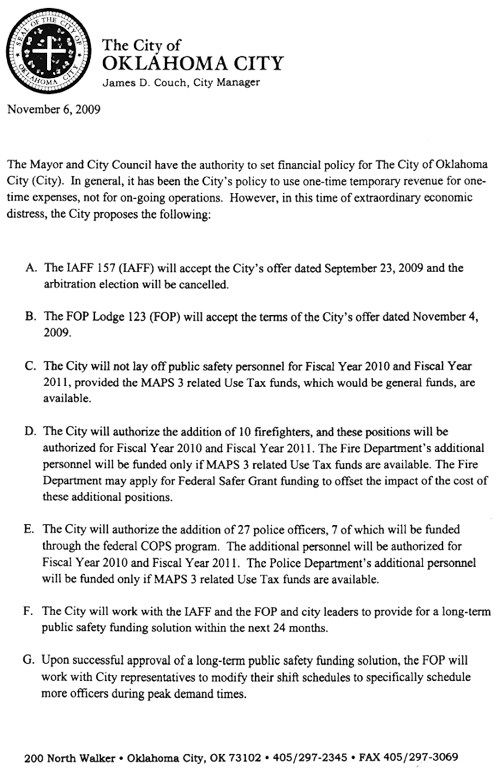
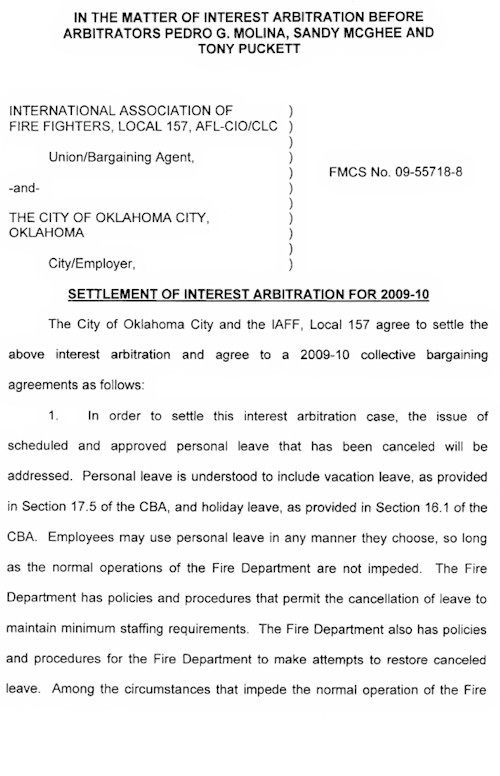

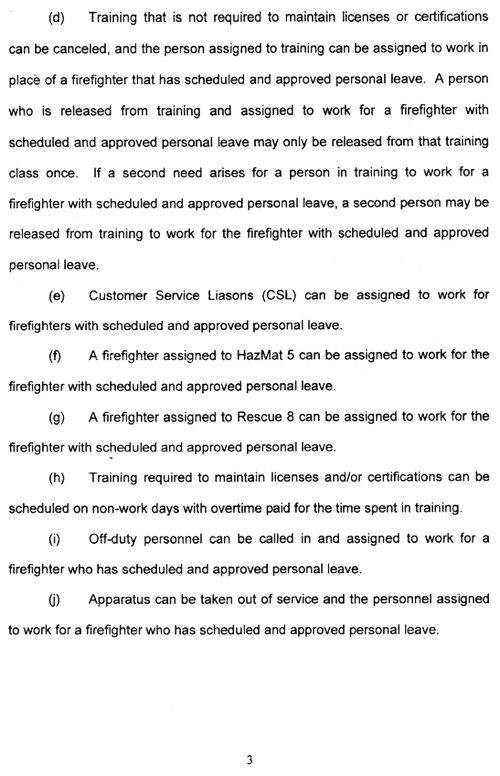
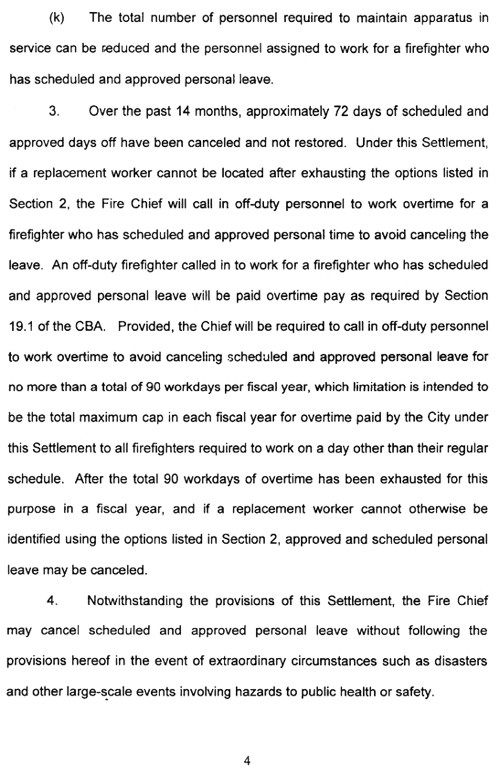


To the Firefighters:
- The city's September 23 offer (the attachment to the memorandum) would be accepted and the arbitration election (scheduled for sometime in 2010) would be canceled.
- The Firefighter's grievance against the city for unfair labor charge (¶9 of the city's September offer) would be dropped.
- No layoffs would occur in 2010 and 2011, "provided the MAPS 3 related Use Tax funds, which are general funds, are available."
- 10 additional Firefighters would be authorized for fiscal years 2010 and 2011, subject the the terms of Couch's letter, paragraph D.
- The city committed to work with both unions to provide a long term funding solution within the next 24 months.
- The city's November 4 offer would be accepted;
- No layoffs would occur in 2010 and 2011, "provided the MAPS 3 related Use Tax funds, which are general funds, are available."
- The city would authorize the addition of 27 police officers, 7 of which would be funded through the federal COPS program.
- The city committed to work with both unions to provide a long term funding solution within the next 24 months.
OK. Pistols have been drawn, shots have been fired. Where does that leave regular people who are not involved in the union disputes with the city? Where does that leave MAPS 3?
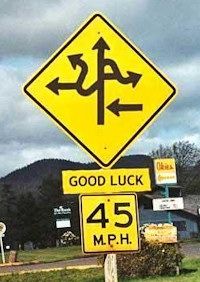
Point of Beginning — Where's the Class? Before getting into substantive analysis, something needs to be said: Leaders on both sides need to quit acting like little kids with pop guns, tone down the rhetoric, evidence a degree of humility, and show greater respect for the other side. Being for or against MAPS 3 doesn't make someone a bad, despicable person. "Right now at a critical time in our city's history we're facing union efforts that I think are designed to confuse our voters ..." says the mayor, and "... the comments yesterday from the mayor about the use of use tax money for public safety funding I think confuses the public," says Phil Sipe. Rhetoric abounds about "unions," "a bunch of politicians," and, the cheapest shot of the lot (so far), "13 pieces of silver."
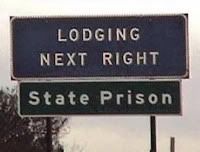
 Next thing you know, each side will begin putting up road signs something like these.
Next thing you know, each side will begin putting up road signs something like these.
We don't need rhetoric ... we can figure out if the road is wet.
 It's getting so bad that GW is even confused ... er ... maybe that's a bad example.
It's getting so bad that GW is even confused ... er ... maybe that's a bad example.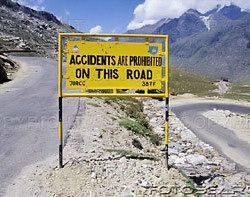
Probably, we need to put up a sign for the combatants ... "Stop it!
This is one of the tougher parts of analysis because it presumes to overlay an objective analysis based upon a speaker's subjective choice of words. In this, I'm assuming that words used should be taken to mean their well-established meaning, according to usage of the English language in our country. I'll supply dictionary definitions, as needed. And, for whatever my opinion is worth, I'll rate the credibility of remarks and indicate whether a "fear factor" was employed, as well.
THE CITY'S PRESS CONFERENCE. Let's look closely at some of the city's press conference remarks and see how they stand the light of day (and additional thought and information).
Item 1: "Right now at a critical time in our city's history we're facing union efforts that I think are designed to confuse our voters into thinking that, somehow, that if MAPS passes, it creates public safety issues. And I can assure you that if MAPS does not pass our public safety issues multiply."
Analysis: Parsing the above into its parts and rephrasing them as questions, those questions would reasonably seem to be the following:
Item 1(a): Is this is a critical time in our city's history? The answer naturally depends upon how one defines, "critical time in our city's history." The Random House College Dictionary, Revised Edition (Random House 1975), in the context of use of the term here, says, "6. pertaining to or of the nature of a crisis; crucial: a critical moment. 7. involving grave uncertainty, peril; dangerous: a critical wound." Those definitions were clearly the context of David Thompson's remarks in the October 21 "Breaking Through" Chamber luncheon when he said, "If it does not pass, I say it sets us back 10 years. We cannot let that happen." The mayor's above remark strikes me as falling into the same category.
With all due respect, Oklahoma City is neither (a) in the doldrums nor (b) is it on the verge of calamity nor (c) is the city in some sort of crisis mode. Our economy is in relatively solid shape compared to most of the country — relatively low employment, lots of good economic things going on all the way around, and many others developments mainly waiting for an upturn in the nation's economy much more so than our own. How many "best of United States" contemporary reports does our city need for it not to be considered "in crisis mode?" Our city is most certainly not in a pre-original-MAPS do-or-die environment, and our city's post-original-MAPS environment will not suddenly drop into space whether or not MAPS 3 passes. "Crisis mode?" No way. Is an opportune time staring us in the face to accelerate our growth? Sure, probably so, but that's not how the mayor phrased his remarks. Because of his choice of words, my rating on this item is:
| Credibility | Fear | ||
| High | Mid | Low | Card |
| ☐ | ☐ | ☒ | ☒ |
| Credibility | Fear | ||
| High | Mid | Low | Card |
| ☐ | ☐ | ☒ | ☐ |
| Credibility | Fear | ||
| High | Mid | Low | Card |
| ☐ | ☐ | ☒ | ☒ |
Analysis. Four items are involved here, itemized below.
Item 2(a): Did the city make a proposal to the unions to use the accompanying MAPS 3 use tax to provide resources to improve capital needs of the respective unions? No. See the the city's offer, above. The offer makes no mention whatever of capital improvement needs of either the police or firefighters.
| Credibility | Fear | ||
| High | Mid | Low | Card |
| ☐ | ☐ | ☒ | ☐ |
| Credibility | Fear | ||
| High | Mid | Low | Card |
| ☐ | ☒ | ☐ | ☐ |
| Credibility | Fear | ||
| High | Mid | Low | Card |
| ☒ | ☐ | ☐ | ☐ |
| Credibility | Fear | ||
| High | Mid | Low | Card |
| ☐ | ☐ | ☒ | ☐ |
Item 4: Ward 1 Council Member Gary Marrs: "When it comes to support for our public safety units, the frustration I have is that the message is being sent out there that the council doesn't support public safety, or hasn't supported it, or that MAPS specifically hasn't supported it. And that's just not true." *** "Specifically, how does MAPS support it? The MAPS for kids use tax has provided over 60 million dollars for public safety."
Analysis. I'm going to be less detailed about Gary Marrs' comments than I was in Items 1-2, but I'll mention a couple of things. His remarks were obviously intended to be general so I'll not fault him for a lack of specifics. Fair is fair. I'll critique his comments only in a general way.
Item 4(a). Does the city support public safety? Well, of course it does and Marrs is correct in his statement that the unions are implying, if not explicitly stating, that the city council does not support public safety. Generally, a very large portion of the city's budget does indeed go to public safety and that fact is something not mentioned in the unions' counterpoint.
| Credibility | Fear | ||
| High | Mid | Low | Card |
| ☒ | ☐ | ☐ | ☐ |
| Credibility | Fear | ||
| High | Mid | Low | Card |
| ☐ | ☐ | ☒ | ☐ |
| Credibility | Fear | ||
| High | Mid | Low | Card |
| ☒ | ☐ | ☐ | ☐ |
| Credibility | Fear | ||
| High | Mid | Low | Card |
| ☐ | ☒ | ☐ | ☐ |
BOTTOM LINE: The city's November 12 press conference to the public did not accurately portray the facts and issues involved with union negotiations, played the fear card, and was combative, not congenial, in tone.
UNIONS' PRESS CONFERENCE. The unions' press conference on November 13 responded to the city's on November 12, and the offer made by the city on November 6. Here's my analysis, for whatever it may be worth. The unions' press conference did not involve the use of any "Fear Cards" like the city's did but did interweave some "Cheap Shots" which the city's did not. So, I've modified my rating tables accordingly.
Item 1, Phil Sipe: "Let me begin by saying that we are deeply disappointed but not surprised by the comments made by Mayor Cornett and others at yesterday's news conference. The December 8 election is about the citizens of Oklahoma City deciding whether or not they want to approve a package of projects that are totaling 3/4 of a billion dollars and it's not about negotiated issues between police and fire and the City of Oklahoma City. As public servants we want to make it very clear that we love this city very much and have dedicated our lives to protecting the citizens of this city. We have established enormous public trust by providing excellent public safety services and programs. For these reasons we feel that MAPS 3 is a bad plan."
Analysis: The above remarks involve at least a pair of items:
Item 1(a): Is union opposition to MAPS 3 based upon the MAPS 3, per se? No. In a November 3 Journal Record article, Sipe was quoted as saying, "We still hold out hope that we can come to some kind of last-minute resolution of the staffing issues that we have," Sipe said. "So we’re not entirely resigned about running a campaign against it. We’re actually trying to work out a resolution so that they address staffing needs." In a November 10 Journal Record article, another quote from Phil Sipe appeared: "'To be completely open here, that's what we've been talking about. Once the (staffing) problem goes away, then I'd think the (MAPS 3) opposition would go away,' said Sipe, who heads the International Association of Firefighters Local 157. ¶ A resolution could be reached as early as Tuesday, he said." Later in the same article: "Sipe said that although he has told city officials that the MAPS 3 opposition could evaporate, it's not entirely up to him. ¶ 'That is one of the things that's really up to the membership. They're the ultimate authority here. If they're willing to reverse the previous stand they've taken and decide to rescind that original decision, then we're certainly willing to do a 180-degree turnaround and support it,' Sipe said." Also, in the Documents Appendix here, see the November 10 letter from the FOP's attorney to the City Manager, wherein it is stated, among other things, "The FOP is willing to get on board with MAPS 3 if a couple of things can be done," and the letter otherwise describes the FOP counteroffer to the November 6 city offer.
| Credibility | Cheap | ||
| High | Mid | Low | Shot |
| ☐ | ☐ | ☒ | ☐ |
Item 1(b): Is union opposition to MAPS 3 based upon negotiated issues between the city and the unions? Yes, notwithstanding Phil Sipe's press conference remarks. In addition to the quotations from two Journal Record articles, above, take a look at Phil Sipe's memo to firefighter union members in the Document Appendix, below. Every single remark relates to the insufficiency of the city's offer, and not a word relates to the merits or demerits of MAPS 3. Had the city and the firefighters come to terms, it is evident that firefighter opposition to MAPS 3 would have gone away.
| Credibility | Cheap | ||
| High | Mid | Low | Shot |
| ☐ | ☐ | ☒ | ☐ |
Item 2, Phil Sipe: "Yet never once has the mayor talked about public safety needs as a part of that list. Not one time have you seen mention of public safety on their website or in any of the printed brochures or audio-visual presentations from the Yes Maps coalition. Not until yesterday."
Analysis: What he said is correct, but what he said is also beside the point. All MAPS initiatives have been for capital improvement projects based upon temporary sales taxes, and one would not expect permanent staffing needs to be funded with temporary taxes — and certainly the unions wouldn't want that since staffing, and not buildings, is the thrust of the unions' goals. The unions doubtless know that MAPS 3 could not address their permanent staffing needs and that those needs would require a vehicle other than MAPS 3 (such as an additional permanent 1/4 ¢ sales tax, as an example).
Notwithstanding city policy, the city's November 6 offer nonetheless made various commitments (no layoffs, some additional personnel) to use a MAPS 3 associated use tax for a two-year period and committed to negotiate with the unions during that time to find permanent funding solutions.
| Credibility | Cheap | ||
| High | Mid | Low | Shot |
| ☐ | ☐ | ☒ | ☐ |
Item 3, Phil Sipe: "The mayor and others have come to realize that the public, by and large, does not support this MAPS."
Analysis: Unless Phil Sipe has a mighty fine crystal ball in his pocket, his 1st sentence is obviously unsupported hyperbole. If the unions have a well-done scientific poll to support such statements, give the public a look at it — no such poll has been presented.
| Credibility | Cheap | ||
| High | Mid | Low | Shot |
| ☐ | ☐ | ☒ | ☐ |
Item 4, Phil Sipe: "This MAPS proposal costs too much money for too many unneeded projects at a time when too many people are concerned about their own jobs, not a pie in the sky promise of new jobs that might be created if MAPS 3 passes, if MAPS 3 passes."
Analysis: Compare the above with Mr. Sipe's comments in the two Journal Record articles mentioned in Item 1(a), above. Had staffing needs been resolved, outside of MAPS 3, "then we're certainly willing to do a 180-degree turnaround and support it."
As to the contingency about using MAPS 3 use tax money as outlined in the city's offer, well, of course the offer was tied to MAPS 3 passing. Something is better than nothing. To preserve their various positions if MAPS 3 does not pass, the unions could have easily counter-offered, "OK, we'll take the offer but subject to the following proviso: If MAPS 3 does not pass, then this agreement will be null and void and will have no effect on any of the items described herein," or something like that, but no such counter-offer was made. But since the city's offer was oblique on that possibility, I'll give Sipe's comment a middle credibility score.
| Credibility | Cheap | ||
| High | Mid | Low | Shot |
| ☐ | ☒ | ☐ | ☐ |
Item 5, Gil Hensley: "This coalition wants to be perfectly clear about our intentions and goals. Police and fire are united in this effort to defeat this MAPS proposal because it costs too much — 777 million dollars for too long — 7 years — with no written guarantees that named projects will ever be funded or in what order. The citizens of Oklahoma City work too hard, love their community too much, to give a blank check to a bunch of politicians in these uncertain economic times."
Analysis: The above needs to be broken into parts.
Item 5(a): Cost and duration. No need exists to be repetitive — see Item 1(a), above. If staffing issues had been resolved, cost and duration would not have been a union issue.
| Credibility | Cheap | ||
| High | Mid | Low | Shot |
| ☐ | ☐ | ☒ | ☐ |
Item 5(b): Lack of guarantees. He is correct about that. There aren't any. Although a less vitriolic tone and a more reasoned presentation would have served him better, he is correct that whether the projects get done depends upon trust — trust that the mayor and council will see MAPS 3 through over a period of 7 ¾ years. Whether to extend that trust to present and future mayors and city council members does indeed involve a judgment call and that is a call that each voter will have to make.
| Credibility | Cheap | ||
| High | Mid | Low | Shot |
| ☐ | ☒ | ☐ | ☐ |
Item 5(c): Blank Check to a "bunch of politicians." More macho hyperbole, pure name-calling demagoguery (note: a demagogue is a political leader who appeals to popular desires and prejudices).
| Credibility | Cheap | ||
| High | Mid | Low | Shot |
| ☐ | ☐ | ☒ | ☒ |
Item 6, Phil Sipe: "The use tax funding proposal gave no specifics as to how much of the use tax dollars would be used for public safety or now long the use tax would be committed to public safety or how those dollars would be allocated to public safety."
Analysis: Not correct. The city's use tax commitments were for a period of two fiscal years and covered an itemized number of staff, and also covered a no lay-off obligation during the two fiscal years. Maybe that commitment was seen as insufficient, but it was defined.
| Credibility | Cheap | ||
| High | Mid | Low | Shot |
| ☐ | ☐ | ☒ | ☐ |
Item 7, Brian Walters: "It's way too much money at this particular time for projects that there's very little accountability for. We want the city to do better than this. I think the city can do better than this. I think we can put a better package out there for the voters to give them the same satisfaction that they would receive from this but at a lot less cost. It is my hope that if this goes down in December that we can come back with something later on that addresses the needs of Oklahoma City and not just a bunch of wants."
Analysis: Ward 5 council member Brian Walters is certainly entitled to his opinion, but the guiding principle behind the original MAPS, and this one, IS about needs — it's just that Walters hasn't got the foresight to see the projects as such. Walters could easily have made the same observations about original MAPS concerning the Bricktown canal, the Oklahoma River project, the downtown library, improvements to the Civic Center Music Hall, the Bricktown AAA baseball field, and the sports arena, etc. Were those projects "needs" or were they just "wants?" You figure it out. Would any of you want this city to be today like it was in 1993, before MAPS? Guys like Walters might be good for doing tax accounting, but they are not good for being visionaries. A Neal Horton or a Ron Norick, he is not. Good leaders are not just concerned about fixing sidewalks or making sure that the sewer system is up to par. Good leaders also have vision, a quality apparently lacking in the young fellow from Ward 5.
| Credibility | Cheap | ||
| High | Mid | Low | Shot |
| ☐ | ☐ | ☒ | ☐ |
Item 8, Gil Hensley: "We're police officers and we're fire fighters because we want to serve the citizens of Oklahoma City, not because we want to serve ourselves. It would have been very easy for my membership to take their 13 pieces of silver and go on and discount the citizens. That is not the goal here. The goal is, this not a good plan for the citizens of Oklahoma City. This is not a good plan." "It was at best a pittance to attempt to buy us off. We will not be bought off."
Analysis: You've got to be kidding. This guy is the best spokesperson the FOP's got? Sure thing: Union personnel are not primarily looking after their own interests, they care about ours more? See Item 1(a), above. Sure thing: The city representatives are those guys who offered Judas a bribe (by the way, it was 30, not 13, pieces of silver) and the unions are not about to be cast in the role of Judas in this made-for-prime-time movie. Nothing wrong with throwing religion into the pot, is there? After all, Christmas is approaching.
| Credibility | Cheap | ||
| High | Mid | Low | Shot |
| ☐ | ☐ | ☒ | ☒ |
This concludes my analysis of the unions' press conference.
Bottom Line: The unions' November 13 press conference to the public did not accurately portray the facts and issues involved with union negotiations, was marred by cheap shots, and was combative, not congenial, in tone.
This appendix isn't about MAPS 3. When you cut the wheat from the chaff, the press conferences weren't particularly, either, despite the fact that the speakers said that they were. Even though the speakers wore MAPS 3 masks, what was really going on had to do with long-standing police and firefighter staffing issues with the city and the public got a taste of it in the pair of press conferences.
Personally, I don't make a connection between MAPS 3 and the unions' staffing and other issues -- I see them as comparing apples and oranges -- and the unions' positions won't cause me to vote "No" on December 8. But, since we've been thrust into the middle of the union issues, it's probably best that we know more about those issues than we heard in the press conferences.
This appendix contains documents which relate to the issues between the city and the firefighters and a single document concerning the FOP -- the last item. I do not have other documents pertaining to the FOP else I would present them also.
PHIL SIPE MEMO TO UNION MEMBERS. Following the city's November 6 offer and the firefighters rejection, Phil Sipe, president of the Firefighters Union, circulated the document below to the union's membership.
At the Union meeting (11/10/09) I discussed an offer from the city that was given to me by Jim Couch on 11/6/09. I believe it very important that the membership stay well informed as to why the negotiation team chose to reject the offer. Below are the details of the offer, and I have added comments to explain our difficulties that resulted in a rejection of the offer. If you have any questions, please contact your V.P. or any member of the negotiation team (italics in underlined bold print is the actual language from the offer). A. The IAFF 157 will accept the City’s offer dated September 23, 2009 and the arbitration election will be canceled. a. The issues with the September 23rd offer: I. The offer would add significant language to policy that affirms the City’s position that they can cancel your day off. It would add FMLA and OJI as reasons why they can cancel your scheduled time off. Currently, that language does not appear anywhere in policy. Policy must be negotiated between your Union and the City. II. The offer gives the Chief a number of options he can select (yet he is not required to select any of them) to maintain minimum staffing and not cancel your day off. Among those options are:
a. This offer is dependent solely on Maps 3 passing; otherwise there would be no Use Tax funds available. Also, the offer of no layoffs would end on June 30th of 2011, even though the Use Tax revenue continues. We would be acknowledging that they can lay off firefighters below the number established by the 1989 public safety sales tax ballot. We suggested that they use the Use Tax as a funding source, but public safety would need virtually all of it to fix our staffing problems, and until another funding source is established, we would need the Use Tax during the entire Maps 3 initiative (7 years, 9 months). FYI: the Use Tax raised over 35 million dollars in fiscal year 08/09. C. The City will authorize the addition of 10 firefighters, and these positions will be authorized for Fiscal Year 2010 and Fiscal Year 2011. The Fire Department’s additional personnel will be funded only if Maps 3 related Use Tax funds are available. a. This offer is also dependent upon Maps 3 passing. We would only have the 10 additional personnel through June of 2011. The cost of this offer would be approximately $675,000. This is only a fraction of the Use Tax revenue. If they had offered to fund the Call Back system with Use Tax dollars we could have seriously considered the offer. 10 additional firefighters will not fix our staffing problems, and the additional personnel would have only been temporary. Final comments: I will supply all of our V.P.’s with copies of the offer from Jim Couch and the September 23rd offer. I want everyone to know why we rejected these offers. I believe you deserve to know the truth. As to the Mayor’s comments concerning how bad it will be for public safety if Maps 3 fails. The city has always had the authority to "hire, suspend, or discharge any member of the Oklahoma City Fire Department subject to the laws existing during the tenure of the contract” (contract, Article 4.2). We have a law (a judgment) that currently says our city has to provide 200 additional firefighters over the staffing level that existed in 1989. Now they are saying they do not have to comply with that law. Our contract says otherwise. We will not stand for any cuts in personnel without a fight! We must stay strong, stay involved, and stay together. Solidarity and political involvement is what they fear the most. Sincerely: Phil Sipe President Local 157 |
THE 1989 BALLOT. Part, but not all, of the Firefighters' issues with the city stems back to the 1989 3/4¢ events after that sales tax approved by the voters. That ballot appears below:
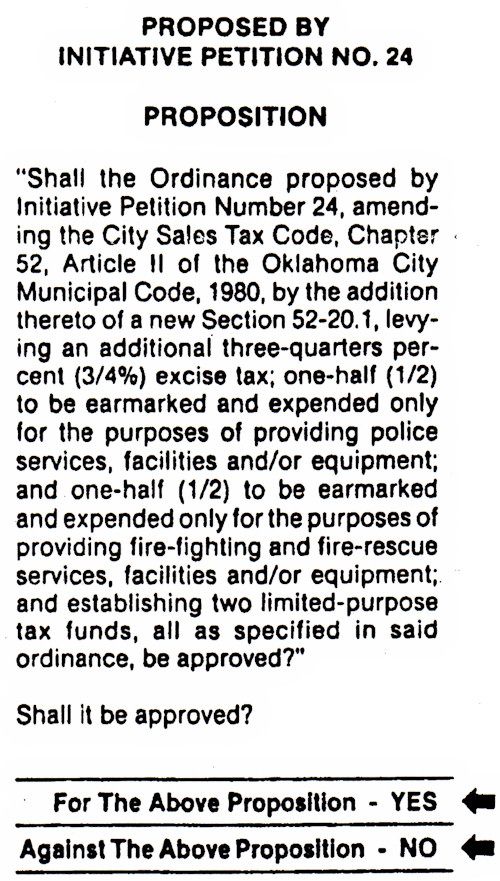
1992-1993 Litigation. It having become evident to union officers that the city was either tweaking its interpretation of the above ordinance to suit its other budget needs or was outright defying the ordinance so to use portions of the 3/4¢ tax for purposes other than those specifically authorized and required by the ordinance, and District Attorney Bob Macy and others made either inquiries to or demands upon the city. See Finding No. 22 below. The city responded by filing a declaratory judgment action in district court in May 1992. That case's docket sheet is here. The case was resolved by a court approved settlement agreement in a very lengthy Journal Entry of Judgment. The case caption appears below:
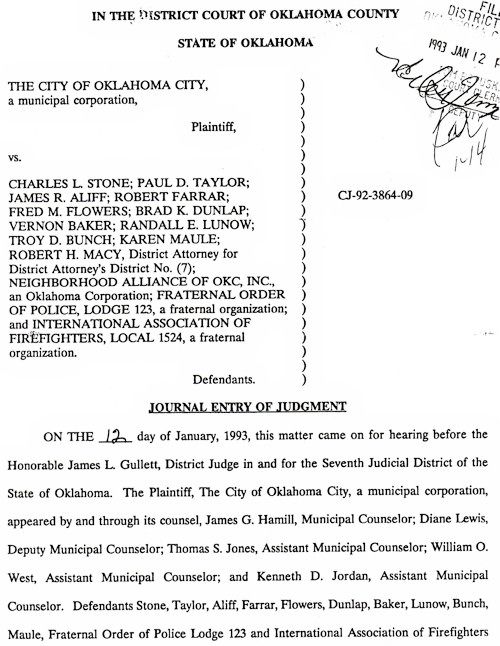
A pair of excerpts from this journal entry appear below:

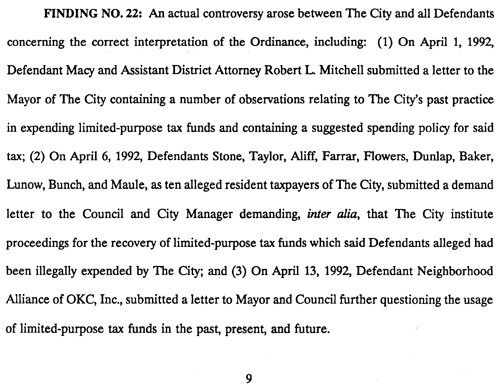
Civilian Employees Funded By Sales Tax. The number of civilian employees which were authorized to be funded by the sales tax for administrative handling of the increased number of firefighters mandated by the 1989 sales tax vote was 6. Around 2002-03, the Firefighters discovered that the city was and had been exceeding that number for eight (8) consecutive years, as shown in the chart below:
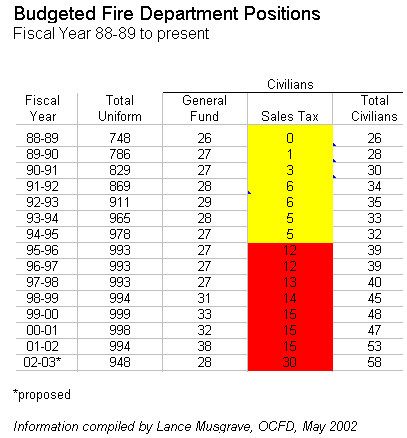
Firefighters Personnel 1989-FY 2009-2010. The number of firefighters established by the 1989 sales tax ordinance and as shown from the above excerpts of the 1993 journal entry of judgment is 948.
When the city's hand was called about the blatant misuse of sales tax receipts to fund (the 2002-2003 fiscal year budget would have increased the number to 30), the number was reduced to 6 but the city's use of that money during the eight previous years was not recaptured or restored to its proper place.
At the same time that the number of administrative staffing paid by the sales tax was cut back to six, the number of uniformed firefighters dropped from its 2002 level (994) to 973 in 2003, and has remained lower than that ever since. The city's budget for fiscal year 2009-2010 eliminates 40 uniformed firefighters, dropping the number to 911, the lowest it has been since 1993, and well below the 948 minimum established by the 1989 sales tax ordinance and 1993 journal entry of judgment. See the chart below.
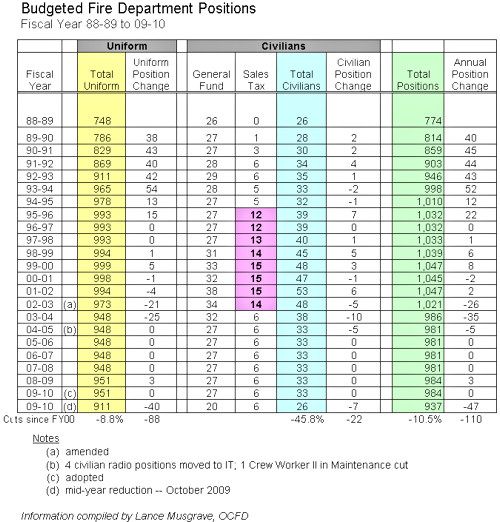
The 1998 Memorandum of Understanding. The city was looking for ways to cut its budget in 1997-1998. During Gary Marrs' tenure as Fire Chief, he negotiated, on behalf of the city, the following February 10, 1998, "Memorandum of Understanding" with the Firefighters:

I'm not satisfied that I've got this part right and will modify this section later, as needed.
FOP November 10 Letter. The FOP remained open to supporting MAPS 3 at least through 10:00 a.m. on November 12, per the following letter from its attorney to the City Manager:
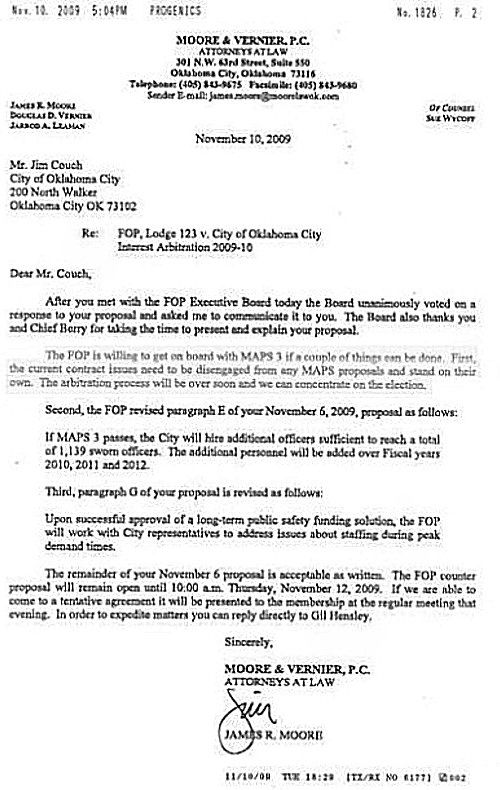














5 comments:
Good job Doug.
Thanks, flintysooner. Now, the last part, which is the hardest ...
Hillbilly politics. Awesome read.
Doug, most comprehensive of all the media outlets. Thanks for this post and the others. Is my reasoning below correct?
This is a tax - that is why were voting.
The projects are not guaranteed and the city council can change at anytime.
The projects are not on the ballot and they could have been voted on individually.
The mayor ultimately determines the "oversight" board.
Vote Yes will continue a tax that works out to about $1000 a citizen for the life of the tax
Vote No will reduce city sales tax 12%
Maps 3
Vote Yes ='s a continued tax, Voting No would discontinue the tax
Except that I don't know about the math ... I'm aware that numbers are flying around but mostly they seem to be based on apportioning the $777M amongst the OKC voters, which, of course, is bad logic since lots of people who aren't Okc citizens will be paying the sales tax, too. To me, a simpler way to look at it is: The tax we are presently paying is what we are well accustomed to be paying, and we get lots of stuff.
I don't know if the mayor appoints members to the oversight board or if that is done by council, as well.
Correct about the ballot points. Correct about no guarantees and that a majority vote by city council could change the projects. Frankly, though, I don't see that happening as being realistic. It would be the end of trust that has carried the city a long way since 1993, and I can't see that happening.
Post a Comment